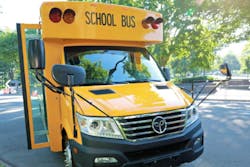In this Disadvantaged Community, a Proposed Bidirectional School Bus, Microgrid and Resilience Center – and Many Challenges
In Odell, Oregon – located in the windy, storm-tossed Columbia River Gorge – a project that would use a bidirectional electric school bus and solar microgrid to create a school-based community resilience center faces many challenges.
The project partners aim to overcome those hurdles and teach other low- and moderate-income communities how they did it.
The plan: The Wy’east Community Resilience Project, located at the Wy’East Middle School, aims to use a bidirectional electric school bus – a Nano Beast from GreenPower Motor – light-duty fleet electric vehicles (EV) and stationary storage as energy storage for a microgrid. Solar installed on the roof of the school will also be part of the microgrid.
Bidirectional charging has come a long way in the couple of years since it was just a wild idea but is still relatively new. Car manufacturers and utilities are beginning to test the technology. Most recently, Toyota and San Diego Gas & Electric formed a partnership to study bidirectional charging.
Resilience during storms and wildfire-caused power shutoffs
The Wy’East project will provide resilience for a community that not only experiences storm-related outages but is also subject to summer wildfires and public safety power shutoffs. The goal is to power the school’s gym for 24 hours during outages, providing a sanctuary for local residents.
Under the plan, components of the microgrid will be used during regular operation, said Joseph Wachunas, project manager at New Buildings Institute (NBI), a nonprofit partner in the project that focuses on improving building energy performance.
The solar panels will provide free electricity to the school, and excess solar will be exported to the grid. In addition, NBI is working with the Hood River Electric Cooperative to provide the utility with access to the stationary battery, which could help power the grid during peak times.
Benefits to the community include less air pollution from the propane buses that are now used by the school district. The buses will also be better suited to special needs students, said Kevin Carbonnier, associate technical director at NBI.
“These are quieter, cleaner and the transportation director says special needs students will have an easier time getting transported. They won’t have to deal with smells, loud engines and loud voices over the sound of the engines. It will be a more positive experience for all,” he said.
Sixteen local, federal, state and nonprofit partners
To make such an innovative project come to fruition, 16 partners – including two utilities, Oregon Energy Trust and NBI – have pieced together initial funding.
To date, the project has received a $1 million grant from the federal Department of Energy’s (DOE) Vehicle Technologies Office and is raising $1 million in matching funds. The Bonneville Environmental Foundation has provided $50,000, Pacific Power & Light has supplied $200,000 through a matching EV grant program and the Hood River Electric Cooperative has pledged $20,000 in support for chargers, said Wachunas.
Additional funding for the solar system will come from Oregon Clean Power Cooperative. In addition, the project participants are applying for another $1 million community renewable energy grant from the Oregon Department of Energy, said Carbonnier.
Creating a resilience model for schools
The project meets the requirements of the DOE’s Vehicle Technologies Office, which requires that 40% of all grants advance environmental justice, he noted.
“This is a pilot and we’re hoping to create a model for schools to follow,” said Pramodh Jacob, a program manager for Forth, a Portland-based nonprofit that aims to boost equitable access to electric transportation.
Attempting to create that model has sparked many challenges, he said.
“When it comes to bidirectional school buses, it takes a lot of coordination to pull off a project,” said Jacob. “It’s really complicated to set this up.”
Overcoming numerous hurdles
For this project and those that may follow it, the challenges include:
- Finding an appropriate bidirectional charger for the school buses, knowing that the charger may be outdated as soon as the industry advances.
- Finding ways to ensure the school bus, charger and microgrid can work together.
- Dealing with a small electric cooperative, which limits the amount of solar that can be added to its system.
- Meeting the Oregon Department of Education’s requirements about school buses.
The major hurdle that Jacob and his team are wrestling with now is acquiring a bidirectional charger. A Level 2 charger – usually less expensive than Level 3 fast chargers – isn’t available right now because of United Laboratories and other standards for bidirectional projects that aim to ensure safety.
Seeking an affordable bidirectional charger
One option is a lower power Level 3 charger, Jacob said. Direct current (DC) fast chargers cost about $1,000 per kW plus installation and infrastructure upgrade costs. Most Level 3 public fast chargers are rated 50 kW to 350 kW.
A lower power Level 3 charger could be a 15 kW to 30 kW model, which would be less expensive and provide the efficiency of a DC fast charger but at a lower speed, he said.
A few different technology options are available for bidirectional charging, said Jacob. They include chargers that meet the North American Charging Standard (NACS), which is standardized as SAE J3400, also known as the Tesla standard. By 2025 Tesla will be making adapters available that will allow most EVs to use its superchargers.
Also available are CHAdeMO chargers from the Japan Electric Vehicle Fast Charger Association and the CCS (Combined Charging System) from the European Automobile Association.
It’s important, for example, that the Nano Beast bus come equipped with bidirectional charging capability. Green Power Motor has agreed to build this into the bus. In the past, the company has supplied electric buses, but not bidirectional buses, to Portland Public Schools.
In addition, the bus must be capable of interfacing with a microgrid, he said.
Asking manufacturers questions is key
Jacob has found that implementing an innovative project like this one requires a lot of digging.
Project developers should ask bus manufacturers whether they have worked on microgrid or bidirectional projects and ask for references from those who have implemented such projects, he said. “It’s important to press them on the details; this will help you gain information you won’t find on the internet,” he said. “You have to dig to learn about experiences from others.”
In addition, schools and other developers of such projects need to obtain the support of the local utility, he said.
“The key thing: Is the utility ready to handle all this? The cooperative is a small operation and tight ship. Everything runs through the board of directors and, in this case, they say they haven’t done anything like this before,” he said.
And in this case, as part of the utility interconnection agreement, Hood River Electric Cooperative has approved a connection of less than 500 kW of solar.
The project partners had to gain approval from the utility for this because adding a lot of solar to a small cooperative could exceed utility transformer limits. The partners are asking to increase the 500-kW limit.
“The 500 kW was an exception based on the fact that the project provides resilience for the school and the surrounding communities,” said Jacob.
Meeting school bus requirements
What’s more, the electric bus had to meet requirements from the Oregon Department of Education, Carbonnier said. For example, the education department requires the bumpers to be a specific color and calls for specific widths of the aisle inside the bus.
Communicating with the local community is also important to such projects, Carbonnier said. At a meeting last week, community members asked questions about the microgrid size, how the microgrid will fit into emergency planning, what kind of bus will be used, how much the project will cost and whether the project will use gas generators. They also wanted to know if the school district would have to contribute funding and, in this case, it won’t.
California’s bidirectional school bus effort
The Wy’East Community Resilience Project is unique, but California has a similar idea that would create a model for using bidirectional school buses and microgrids.
Nuvve Holding, a vehicle-to-grid technology and deployment company, received a grant worth $1.91 million for its Resilient Energy Solutions for Schools project from the California Energy Commission (CEC).
Granted under CEC’s Electric School Bus Bi-Directional Infrastructure funding opportunity, the project aims to highlight the potential of electric school buses and bidirectional charging infrastructure deployments with battery energy storage, microgrid and islanding capabilities to improve the resilience of California's power grid during extreme weather events and emergency situations.
In Oregon – where the focus is on the local community, not on the grid – the project offers many advantages, including energy resilience, cleaner air and the opportunity to learn about new technologies. Project participants hope that all they’re studying will be helpful to other disadvantaged communities and students.
But, for now, those planning the resilience center are still learning.









